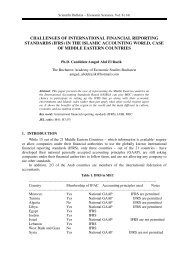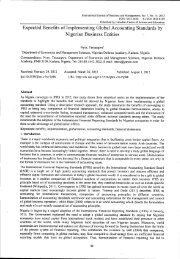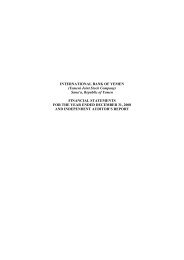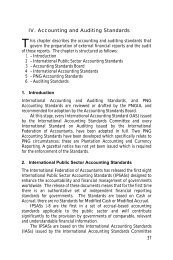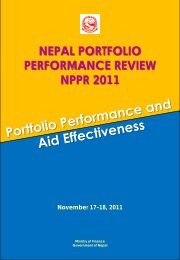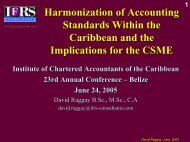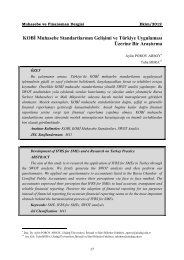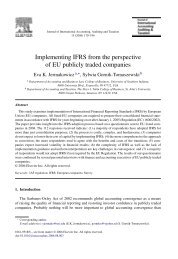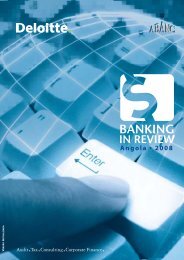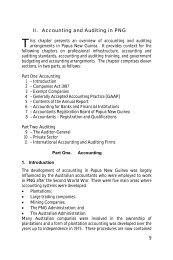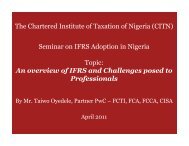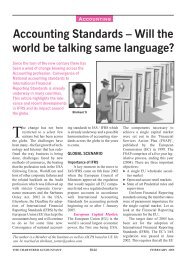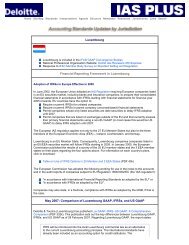Changing tack - A new set of accounting standards ... - Ernst & Young
Changing tack - A new set of accounting standards ... - Ernst & Young
Changing tack - A new set of accounting standards ... - Ernst & Young
Create successful ePaper yourself
Turn your PDF publications into a flip-book with our unique Google optimized e-Paper software.
In 2011, the External ReportingBoard (XRB) decided to moveaway from a single <strong>set</strong> <strong>of</strong><strong>accounting</strong> <strong>standards</strong> for allentities to a sector-specific<strong>standards</strong> approach. Under thisapproach, there would beseparate and, in some cases,different requirements forpublic benefit entities (PBEs).On 28 June 2012, the XRB and itssub-board, the New Zealand AccountingStandards Board (NZASB), issued forcomment a <strong>set</strong> <strong>of</strong> forty-one exposuredrafts (EDs) that operationalise the<strong>new</strong> <strong>accounting</strong> <strong>standards</strong> frameworkfor large and medium-sized public sectorPBEs. The <strong>new</strong> <strong>accounting</strong> <strong>standards</strong>are based on International PublicSector Accounting Standards (IPSAS)and have been modified as appropriatefor New Zealand circumstances.The exposure drafts include the following:• ED XRB A1 (for-pr<strong>of</strong>it and public sectorPBEs update) — second <strong>of</strong> three revisionsto Standard XRB A1, which is theoverarching standard that <strong>set</strong>s outthe <strong>accounting</strong> <strong>standards</strong>’ framework.This revision <strong>of</strong> XRB A1 includes thefor-pr<strong>of</strong>it entities update issued forcomment in April 2012, andincorporates the following updatefor public sector PBEs:• The <strong>new</strong> tier structure• The criteria for tiers• The applicable <strong>accounting</strong><strong>standards</strong> for each tier• EDs for PBE <strong>standards</strong> (Tier 1 and Tier 2)— <strong>new</strong> suite <strong>of</strong> <strong>accounting</strong> <strong>standards</strong> to beapplied by Tier 1 and Tier 2 public sectorPBEs. Tier 1 public sector PBEs will applythe PBE <strong>standards</strong> in full, while Tier 2public sector PBEs will have reduceddisclosure requirements.In this publication, we provide:• A summary <strong>of</strong> the proposed financialreporting requirements for PBEs• The key differences between PBE<strong>standards</strong> and NZ IFRS• Next steps• How <strong>Ernst</strong> & <strong>Young</strong> can helpyour organisationSummary <strong>of</strong> the proposed financialreporting requirements for PBEsThe proposed <strong>new</strong> suite <strong>of</strong> <strong>accounting</strong><strong>standards</strong> will apply to entities that:• Are required to prepare general purposefinancial statements (e.g. by legislation)• Meet the definition <strong>of</strong> a PBE• Will be in either Tier 1 or Tier 2 <strong>of</strong> the<strong>new</strong> PBE financial reporting frameworkPBEs are defined as entities whose primaryobjective is to provide goods or services forcommunity or social benefit, and whereequity has been provided with a view tosupporting that primary objective, ratherthan for a financial return to equity holders.Examples <strong>of</strong> PBEs include many entitiesin the public sector (e.g. governmentdepartments, hospitals and schools),along with charities and other not-forpr<strong>of</strong>itentities in the private sector.However, public sector entities that arepr<strong>of</strong>it-oriented (e.g. state-ownedenterprises) will use the <strong>accounting</strong><strong>standards</strong> applying to for-pr<strong>of</strong>it entities,i.e. New Zealand equivalents toInternational Financial ReportingStandards (NZ IFRS).The proposed PBE <strong>standards</strong> in the currentEDs have been developed primarily withpublic sector entities in mind. Another EDcontaining revisions to the PBE <strong>standards</strong>to make them more applicable to registeredcharities and other not-for-pr<strong>of</strong>it entitieswill be issued next year (estimated timing isSeptember 2013). However, we are notexpecting that the subsequent revision <strong>of</strong>the PBE <strong>standards</strong> for not-for-pr<strong>of</strong>it entitieswill result in significant changes to the<strong>standards</strong> – it’s more likely that anychanges will be in the nature <strong>of</strong> additionalexamples and application guidance fornot-for-pr<strong>of</strong>it entities, rather than majorchanges to the key principles orrequirements <strong>of</strong> the <strong>standards</strong>.The diagram below outlines the proposedfinancial reporting framework for PBEs:Tier 1 — largeExpenses > $30m plus‘publicly accountable’entities (e.g. issuers)• PBE <strong>standards</strong>Tier 2 — mediumExpenses between$2m - $30mThe <strong>new</strong> PBE <strong>standards</strong> for Tier 1 andTier 2 public sector PBEs are expectedto be issued by the end <strong>of</strong> June 2013.These <strong>standards</strong> are expected to beeffective for financial years beginningon or after 1 July 2014 for public sectorPBEs (i.e. the 2014/15 financial year).The <strong>standards</strong>, once revised for not-forpr<strong>of</strong>itentities, are expected to be effectivefrom 1 April 2015 (i.e. the 2015/16financial year) for Tier 1 and Tier 2registered charities and other privatesector not-for-pr<strong>of</strong>it entities.Key differences betweenPBE <strong>standards</strong> and NZ IFRSThe exact impact <strong>of</strong> public sector PBEsmoving from existing <strong>standards</strong> to PBE<strong>standards</strong> will differ from entity to entity.The impact will also depend on theexisting <strong>standards</strong> applied by the entity(e.g. NZ IFRS in full or with differentialreporting concessions).Public sector PBEs and private sector not-for-pr<strong>of</strong>its (NFPs)• PBE <strong>standards</strong> withreduced disclosuresTier 3 — smallExpenses < $2m andnot in Tier 4• Simple formatreporting• Accrual <strong>accounting</strong>Tier 4 — microExpenses < $40k andpermitted by legislationto be in Tier 4• Simple formatreporting• Cash <strong>accounting</strong>For public sector entities and other PBEscurrently reporting under NZ IFRS, themove from NZ IFRS to the <strong>new</strong> PBE<strong>standards</strong> is the most significant changein <strong>accounting</strong> <strong>standards</strong> since the initialmove to NZ IFRS. However, most PBEsshould find that there is no need to makemany major changes to their <strong>accounting</strong>policies - because the <strong>new</strong> PBE <strong>standards</strong>are based on IPSAS, which are themselvesbased on IFRS.Nevertheless, there are some potentiallysignificant differences and also a range<strong>of</strong> smaller differences between theproposed PBE <strong>standards</strong> and NZ IFRS.Therefore, every PBE will need to gothrough a process <strong>of</strong> identifying relevantdifferences and assessing the impact ontheir financial reporting. That assessmentwill then help to determine what changesmight be needed to <strong>accounting</strong> processesand information systems.2 <strong>Ernst</strong> & <strong>Young</strong> <strong>Changing</strong> <strong>tack</strong> <strong>Ernst</strong> & <strong>Young</strong> <strong>Changing</strong> <strong>tack</strong>3
The table below summarises some <strong>of</strong> the main differences and potentialimpacts for public sector PBEs transitioning from full NZ IFRS to PBE <strong>standards</strong>.Proposed standard Key changes Potential impactPBE IPSAS 23 Revenue from Non-ExchangeTransactionsPBE IPSAS 32 Service Concession Arrangements:GrantorPBE IPSAS 1 Presentation <strong>of</strong> Financial StatementsPBE IPSAS 6 Consolidated and SeparateFinancial StatementsPBE IPSAS 7 Investments in AssociatesPBE IPSAS 8 Interests in Joint VenturesNo equivalent standard under NZ IFRSs.Recognise an as<strong>set</strong> and revenue only to extentthat liability is not also recognised.Liability recognised only to extent that presentobligations have not been satisfied, and in respect<strong>of</strong> a transferred as<strong>set</strong>, only when a transferredas<strong>set</strong> is subject to a condition (e.g. as<strong>set</strong> must beconsumed as specified, or returned to owner).Does not permit the recognition <strong>of</strong> a liability inrespect <strong>of</strong> a transferred as<strong>set</strong> that is subject toa restriction.No equivalent standard under NZ IFRSs.Prescribes the <strong>accounting</strong> for service concessionarrangements by the grantor, a public benefit entity.Changes to the presentation <strong>of</strong> information infinancial statements, including the line itemswithin those statements.Contains less guidance on <strong>accounting</strong> for the loss<strong>of</strong> control/significant influence/joint control <strong>of</strong> acontrolled entity/associate/joint venture.Requires carrying amount <strong>of</strong> any retainedinvestment in a financial as<strong>set</strong> when control/significant influence/joint control is lost to beregarded as the cost on initial measurement<strong>of</strong> the financial as<strong>set</strong>.In separate financial statements, investments incontrolled entities, jointly controlled entities andassociates can be accounted for at cost, using theequity method, or as a financial instrument.Losses attributable to minority interest (MI) thatexceed the MI in the controlled entity to be allocatedagainst the majority interest except to extent MI hasa binding obligation and is able to make additionalinvestment to cover losses.No guidance on <strong>accounting</strong> for a groupreorganisation in separate financial statements<strong>of</strong> a <strong>new</strong> parent.High – Impact will depend on an entity’s previous<strong>accounting</strong> policies in respect <strong>of</strong> revenue fromnon-exchange transactions.May lead to earlier recognition <strong>of</strong> some nonexchangerevenue or recognition <strong>of</strong> fewer liabilitiesrelating to transferred as<strong>set</strong>s.Specifically, those entities with revenue from grants,donations, bequests and similar types <strong>of</strong> incomesuch as tertiary education institutions, registeredcharities and similar entities will need to considerthe financial reporting impact <strong>of</strong> this standard ontheir organisations.High for affected entities – Difficult to assess impactas there have been relatively few service concessionarrangements to date in New Zealand.Introduction <strong>of</strong> a <strong>new</strong> standard could potentiallyhave a significant impact for grantors dependingon how closely an entity’s existing policies are toPBE IPSAS 32.Medium – Entities would have to revert to aseparate presentation <strong>of</strong> the Statement <strong>of</strong>Financial Performance and Statement <strong>of</strong> Changesin Equity (that includes the Other ComprehensiveIncome line items <strong>of</strong> the NZ IAS 1 Statement <strong>of</strong>Comprehensive Income).Medium - P&L impact on loss <strong>of</strong> control/significant influence/joint control <strong>of</strong> acontrolled entity/associate/joint venturemay be measured differently.Measurement on initial recognition as a financialas<strong>set</strong> <strong>of</strong> any retained investment when control/significant influence/joint control is lost maybe different.Some investments in associates that are withinthe scope <strong>of</strong> NZ IAS 28 may not be within thescope <strong>of</strong> PBE IPSAS 7 and, therefore, would notbe equity accounted.Investments in controlled entities, jointly controlledentities, and associates may be measured differentlyin separate financial statements <strong>of</strong> an investor.Losses attributable to minority interest would notnecessarily result in the minority interest having adeficit balance.A <strong>new</strong> parent arising from a group reorganisationwill need to determine the <strong>accounting</strong> treatment inits separate financial statements.Proposed standard Key changes Potential impactPBE IPSAS 9 RevenuePBE IPSAS 16 Investment PropertyPBE IPSAS 17 Property, Plant and EquipmentPBE IPSAS 20 Related Party DisclosuresPBE IPSAS 26 Impairment <strong>of</strong> Cash-GeneratingAs<strong>set</strong>sA number <strong>of</strong> interpretations which form part <strong>of</strong>NZ IFRS have not been incorporated in theproposed PBE <strong>standards</strong>.Definition <strong>of</strong> revenue encompasses gainsRevaluations <strong>of</strong> investment property and property,plant and equipment are required to be undertaken(or reviewed) by an independent valuer, anddisclosures are required regarding the valuationsundertaken by each valuer.Disclosures are required in respect <strong>of</strong> heritageas<strong>set</strong>s that are not recognised, including anestimate <strong>of</strong> the value <strong>of</strong> such as<strong>set</strong>s.General requirements are less detailed than NZ IAS24 to focus on principles underlying related partydisclosures.Exempts all transactions between related partiesthat occur on arm’s length terms and conditions.Definition <strong>of</strong> key management personnel is moredetailed and may be interpreted as being wider thanthe definition in NZ IAS 24. Additional disclosureson key management personnel remuneration.Indicators for impairment testing differ.Medium to low – Diversity may arise in practicewhere relevant NZ IFRS guidance has not beenincorporated into PBE <strong>standards</strong>.Revenue amounts reported under PBE <strong>standards</strong>may not be comparable to revenue amountsreported under NZ IFRS (e.g. arising from theinclusion/exclusion <strong>of</strong> gains within revenue).Low – Many entities previously (or currently)utilised independent valuers and complied withthe valuation disclosure requirements in NZ IAS 16and NZ IAS 40, which were removed in April 2011as a result <strong>of</strong> the Trans-Tasman Harmonisationamendments.Additional disclosures regarding unrecognisedheritage as<strong>set</strong>s are not expected to have asignificant impact as a number <strong>of</strong> PBEs alreadymake such disclosures.Medium – The impact on some entities may besignificant.Fewer related party disclosures may be requiredfor some entities.Some entities may have to collect <strong>new</strong> informationabout their key management personnel anddisclose additional information on key managementpersonnel remuneration.Low – Some as<strong>set</strong>s currently considered to beimpaired may not be impaired under the proposedPBE IPSAS 26.Impairment loss calculations could be different.4 <strong>Ernst</strong> & <strong>Young</strong> <strong>Changing</strong> <strong>tack</strong> <strong>Ernst</strong> & <strong>Young</strong> <strong>Changing</strong> <strong>tack</strong>5
Tier 2 disclosure concessionsThe proposed PBE <strong>standards</strong> for Tier 2public sector PBEs have been developedby taking the proposed PBE <strong>standards</strong>and identifying disclosure concessionswithin each draft PBE standard.The proposed disclosure concessionsare largely similar to the disclosureconcessions proposed for Tier 2for-pr<strong>of</strong>it entities and do not containany recognition and measurementconcessions. Disclosure concessions aredenoted within the PBE <strong>standards</strong> by anasterisk (*) next to the paragraph, anda Tier 2 entity would not be required tocomply with these requirements.Overall, there are more disclosureconcessions in the proposed PBE<strong>standards</strong> compared with the existingdifferential reporting concessions.However, the disclosure concessionsmay be different from existing differentialreporting concessions. Specifically, some<strong>of</strong> the disclosure concessions that areavailable under the proposed PBEframework for Tier 2 public sectorPBEs include:• PBE IPSAS 3 Accounting Policies,Changes in Accounting Estimates andErrors – disclosures around <strong>accounting</strong><strong>standards</strong> issued but not yet effective• PBE IPSAS 6 Consolidated andSeparate Financial Statements —disclosures in separate financialstatements when an entity electsnot to prepare consolidatedfinancial statements• PBE IPSAS 7 Investments in Associates– disclosures around summarisedfinancial information <strong>of</strong> associates,management judgement surroundingthe determination <strong>of</strong> significantinfluence, and additional disclosuresaround significant restrictions on theassociate’s ability to make distributionsto the investor• PBE IPSAS 8 Investments in JointVentures — disclosure <strong>of</strong> aggregatefinancial information when an investorproportionately consolidates a jointlycontrolled entity• PBE IPSAS 16 Investment Property –disclosures regarding specific amountsrecognised in surplus or deficit anddisclosures when an entity measuresinvestment property using thecost model• PBE IPSAS 21 Impairment <strong>of</strong>Non-Cash-Generating As<strong>set</strong>s andED PBE IPSAS 26 Impairment <strong>of</strong>Cash-Generating As<strong>set</strong>s — disclosuresaround impairment losses recognisedor reversed during the period and keyassumptions used to determine therecoverable service potential <strong>of</strong> as<strong>set</strong>s• PBE IPSAS 30 Financial Instruments:Disclosures — disclosures regardingclasses <strong>of</strong> financial instruments,qualitative and quantitative riskexposures, sensitivity analyses,reconciliations, and fair value• PBE IAS 12 Income Taxes — disclosuresaround income tax items presentedin equity, deferred taxes, andimputation creditsSome <strong>of</strong> the existing differentialreporting concessions which havebeen removed under the proposedPBE framework for Tier 2 public sectorPBEs include:• Entities will be required to prepare acash flow statement• Entities that are subject to income taxwill be required to account for deferredincome tax6 <strong>Ernst</strong> & <strong>Young</strong> <strong>Changing</strong> <strong>tack</strong> Character Style (Doc title _Bold) Footers Text Character Style (Doc title _Grey)7
Where to from here?Submissions on this package <strong>of</strong> publicsector PBE exposure drafts are due by14 December 2012.Exposure drafts for the simple formatreporting <strong>standards</strong> for Tier 3 andTier 4 PBEs are expected to be issuedfor comment in November 2012.Now that the proposed PBE <strong>standards</strong> forpublic sector PBEs have been issued, werecommend all PBEs perform an impactassessment and develop a transitionplan. For public sector PBEs, the date <strong>of</strong>transition to the <strong>new</strong> <strong>standards</strong> (i.e. thedate <strong>of</strong> the opening balance sheet inthe comparative period) is now less thana year away.Organisations first need to determine whichsector they fall into. For some entities thismay involve revisiting the definition <strong>of</strong> aPBE to confirm they are not in the for-pr<strong>of</strong>itsector. Once an entity has determined it isa PBE (and the status <strong>of</strong> any subsidiaries),the process <strong>of</strong> planning for conversionwill need to begin.Although the conversion to PBE <strong>standards</strong>from NZ IFRS will not be as significant asthe move from old NZ GAAP to NZ IFRS,there are still some differences that entitieswill need to consider, which may potentiallyhave a significant impact on an entity’sfinancial reporting processes, includingits <strong>accounting</strong> policies, informationsystems, internal controls, and otheroperational aspects.In addition, groups headed by a PBE parentthat has for-pr<strong>of</strong>it subsidiaries will need toconsider the implications for groupreporting purposes. Where some entities inthe group continue to report under NZ IFRSwhile the parent reports under the <strong>new</strong> PBE<strong>standards</strong>, it will be necessary to identifyand track differences in <strong>accounting</strong> policiesthat could result in consolidationadjustments. This issue arises both ontransition to the <strong>new</strong> PBE <strong>standards</strong> andon an on-going basis, especially as forpr<strong>of</strong>itsubsidiaries move to <strong>new</strong> NZ IFRSsahead <strong>of</strong> equivalent PBE <strong>standards</strong> beingdeveloped and adopted. The NZASB plansto issue a Consultation Paper on mixedgroups during the comment period for thepublic sector PBE <strong>standards</strong> (Tiers 1 and 2).The Consultation Paper is expected toinclude the NZASB’s strategy for addressingexisting and future differences betweenPBE <strong>standards</strong> and NZ IFRS (from a PBEgroup perspective).How we can help you<strong>Ernst</strong> & <strong>Young</strong>’s Financial AccountingAdvisory Services and Assurancepr<strong>of</strong>essionals bring together a wealth<strong>of</strong> <strong>accounting</strong> knowledge from diverseexperiences advising a range <strong>of</strong> clientsacross the public, corporate andnot-for-pr<strong>of</strong>it sectors. We can help yourorganisation assess how the revisedframework will impact your reportingobligations and assist with theinterpretation and implementation<strong>of</strong> <strong>new</strong> <strong>accounting</strong> <strong>standards</strong> applicableto your organisation.To help you prepare and plan for thetransition to the <strong>new</strong> PBE <strong>standards</strong>,we can assist with the following steps:• Initial diagnostic phase — this wouldinclude a review <strong>of</strong> current <strong>accounting</strong>policies and an initial assessment <strong>of</strong> theimpact <strong>of</strong> the move to the PBE <strong>standards</strong>• Design and implementation — <strong>set</strong>ting upa timeline, objectives and goals in orderto be prepared for the application <strong>of</strong> the<strong>new</strong> <strong>set</strong> <strong>of</strong> <strong>standards</strong>• Solution development — identify specificareas <strong>of</strong> focus for the transition,consideration <strong>of</strong> the impacts on thefinancial statements and the processesand systems currently in place• Implementation — assist to create<strong>new</strong> <strong>accounting</strong> policies, update financialinformation and systems and implementthe transitional provisions, to help createan opening balance sheet• Post implementation — monitor andassess the progress <strong>of</strong> adoption <strong>of</strong><strong>new</strong> <strong>standards</strong> and ensure financialinformation produced is in line withthe <strong>new</strong> requirementsIn the table below, we outline in more detail the common issues that PBE entitiesin New Zealand are likely to face when moving to <strong>new</strong> PBE <strong>standards</strong>, and indicatehow we can help.IssueGain a general understanding <strong>of</strong>the proposed NZ PBE <strong>standards</strong>Perform a preliminary assessment<strong>of</strong> the impact <strong>of</strong> the proposals onthe entity’s financial statementsInterpreting and implementingthe <strong>new</strong> NZ PBE <strong>standards</strong>Selecting suitable <strong>accounting</strong>policiesBenchmarking <strong>accounting</strong> policydecisions and financial statementdisclosures against peers andothers in the industryAdvise management duringimplementationEnsuring financial statements areprepared in accordance with the<strong>new</strong> <strong>standards</strong>Communicating the effect <strong>of</strong>changes in <strong>accounting</strong> policydecisions or reporting requirementsto the public.How we can help• Design and deliver training sessions for personnelon the <strong>accounting</strong> implications <strong>of</strong> <strong>new</strong> or proposed<strong>accounting</strong> <strong>standards</strong>Perform pre-implementation impact assessments, including:• Assessing the impact on surplus or deficit <strong>of</strong> implementing<strong>accounting</strong> <strong>standards</strong>• Assessing the impact on key financial ratios andperformance measures• Identifying <strong>new</strong> or changed financial statementdisclosure requirements• Assist with the interpretation <strong>of</strong> the <strong>new</strong> <strong>accounting</strong> <strong>standards</strong>• Assist management in developing an implementation plan• Advise on project management, including timeline, tasks andresource allocation• Help ensure management is aware <strong>of</strong> the <strong>accounting</strong> policyoptions available to them under the <strong>new</strong> <strong>standards</strong>• Analyse the impact <strong>of</strong> different <strong>accounting</strong> policy options onthe organisation• Assist management in selecting suitable <strong>accounting</strong> policies• Provide observations <strong>of</strong> how others are approaching <strong>new</strong>or proposed <strong>standards</strong>, problems they are identifying andsolutions developed• Assist in the comparison <strong>of</strong> peers, competitors and industry<strong>accounting</strong> policy decisions, disclosures and expected impacton the financial statements• Prepare progress reports and advise on the impact <strong>of</strong> the<strong>new</strong> <strong>standards</strong>• Review and provide input into <strong>accounting</strong> manuals thatmanagement will approve• Perform financial statement GAAP compliance reviews• Advise on developing a communication plan• Advise on drafting communications8 <strong>Ernst</strong> & <strong>Young</strong> <strong>Changing</strong> <strong>tack</strong> <strong>Ernst</strong> & <strong>Young</strong> <strong>Changing</strong> <strong>tack</strong>9
If you have any queries please contactAucklandKimberley Crookkimberley.crook@nz.ey.comTel: +64 9 300 7094Brent Penrosebrent.penrose@nz.ey.comTel: +64 272 749 739David Paceydavid.pacey@nz.ey.comTel: +64 212 425 716Ravi Kumarravi.kumar@nz.ey.comTel: +64 212 214 717WellingtonMarcus Henrymarcus.henry@nz.ey.comTel: +64 272 480 324Stuart Mutchstuart.mutch@nz.ey.comTel: +64 274 899 378Grant Taylorgrant.taylor@nz.ey.comTel: +64 274 899 410Lara Trumanlara.truman@nz.ey.comTel: +64 274 899 896ChristchurchBruce Loaderbruce.loader@nz.ey.comTel: +64 274 899 98410 <strong>Ernst</strong> & <strong>Young</strong> <strong>Changing</strong> <strong>tack</strong> <strong>Ernst</strong> & <strong>Young</strong> <strong>Changing</strong> <strong>tack</strong>11
<strong>Ernst</strong> & <strong>Young</strong>Assurance | Tax | Transactions | AdvisoryAbout <strong>Ernst</strong> & <strong>Young</strong><strong>Ernst</strong> & <strong>Young</strong> is a global leader in assurance, tax, transaction and advisory services. Worldwide,our 152,000 people are united by our shared values and an unwavering commitment to quality.We make a difference by helping our people, our clients and our wider communities achievetheir potential.<strong>Ernst</strong> & <strong>Young</strong> refers to the global organisation <strong>of</strong> member firms <strong>of</strong> <strong>Ernst</strong> & <strong>Young</strong> Global Limited,each <strong>of</strong> which is a separate legal entity. <strong>Ernst</strong> & <strong>Young</strong> Global Limited, a UK company limited byguarantee, does not provide services to clients. For more information about our organisation,please visit www.ey.com.© 2012 <strong>Ernst</strong> & <strong>Young</strong>, New Zealand.All Rights Reserved.SCORE No. NZ00000438.This communication provides general information which is current as at the time <strong>of</strong> production.The information contained in this communication does not constitute advice and should not be reliedon as such. Pr<strong>of</strong>essional advice should be sought prior to any action being taken in reliance on any <strong>of</strong>the information. <strong>Ernst</strong> & <strong>Young</strong> disclaims all responsibility and liability (including, without limitation, forany direct or indirect or consequential costs, loss or damage or loss <strong>of</strong> pr<strong>of</strong>its) arising from anything doneor omitted to be done by any party in reliance, whether wholly or partially, on any <strong>of</strong> the information.Any party that relies on the information does so at its own risk.www.ey.com/nzNZ1224542




